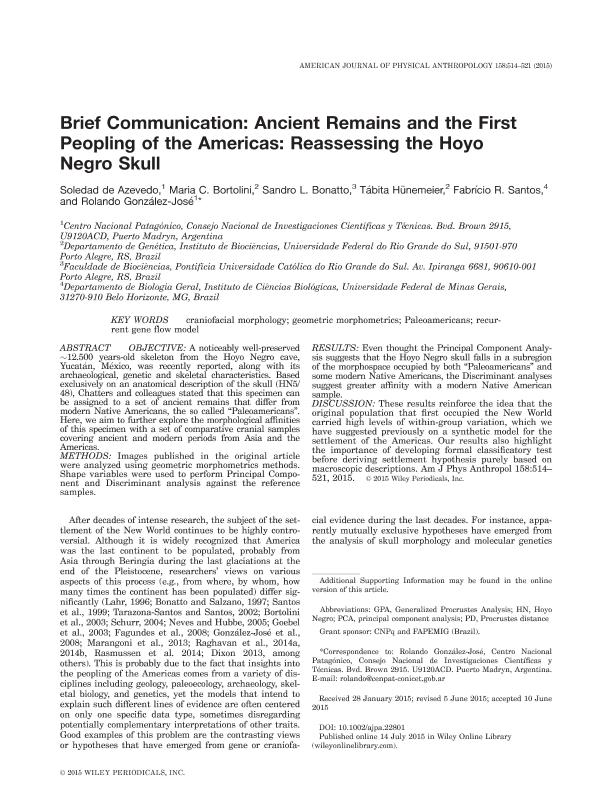Artículo
Ancient remains and the first peopling of the Americas: Reassessing the Hoyo Negro skull
de Azevedo, Soledad ; Bortolini, Maria Catira; Bonatto, Sandro Luis; Hünemeier, Tábita; Santos, Fabricio R.; González José, Rolando
; Bortolini, Maria Catira; Bonatto, Sandro Luis; Hünemeier, Tábita; Santos, Fabricio R.; González José, Rolando
 ; Bortolini, Maria Catira; Bonatto, Sandro Luis; Hünemeier, Tábita; Santos, Fabricio R.; González José, Rolando
; Bortolini, Maria Catira; Bonatto, Sandro Luis; Hünemeier, Tábita; Santos, Fabricio R.; González José, Rolando
Fecha de publicación:
07/2015
Editorial:
Wiley
Revista:
American Journal Of Physical Anthropology
ISSN:
0002-9483
e-ISSN:
1096-8644
Idioma:
Inglés
Tipo de recurso:
Artículo publicado
Clasificación temática:
Resumen
Objective A noticeably well‐preserved ∼12.500 years‐old skeleton from the Hoyo Negro cave, Yucatán, México, was recently reported, along with its archaeological, genetic and skeletal characteristics. Based exclusively on an anatomical description of the skull (HN5/48), Chatters and colleagues stated that this specimen can be assigned to a set of ancient remains that differ from modern Native Americans, the so called “Paleoamericans”. Here, we aim to further explore the morphological affinities of this specimen with a set of comparative cranial samples covering ancient and modern periods from Asia and the Americas. Methods Images published in the original article were analyzed using geometric morphometrics methods. Shape variables were used to perform Principal Component and Discriminant analysis against the reference samples. Results Even thought the Principal Component Analysis suggests that the Hoyo Negro skull falls in a subregion of the morphospace occupied by both “Paleoamericans” and some modern Native Americans, the Discriminant analyses suggest greater affinity with a modern Native American sample. Discussion These results reinforce the idea that the original population that first occupied the New World carried high levels of within‐group variation, which we have suggested previously on a synthetic model for the settlement of the Americas. Our results also highlight the importance of developing formal classificatory test before deriving settlement hypothesis purely based on macroscopic descriptions. Am J Phys Anthropol 158:514–521, 2015.
Archivos asociados
Licencia
Identificadores
Colecciones
Articulos(CCT-CENPAT)
Articulos de CTRO.CIENTIFICO TECNOL.CONICET - CENPAT
Articulos de CTRO.CIENTIFICO TECNOL.CONICET - CENPAT
Citación
de Azevedo, Soledad; Bortolini, Maria Catira; Bonatto, Sandro Luis; Hünemeier, Tábita; Santos, Fabricio R.; et al.; Ancient remains and the first peopling of the Americas: Reassessing the Hoyo Negro skull; Wiley; American Journal Of Physical Anthropology; 158; 3; 7-2015; 514-521
Compartir
Altmétricas



